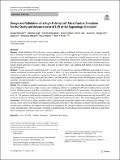| dc.contributor.author | Mendez, Keegan | |
| dc.contributor.author | Singh, Manisha | |
| dc.contributor.author | Willoughby, Patrick | |
| dc.contributor.author | Ncho, Beatrice | |
| dc.contributor.author | Liao, Aileen | |
| dc.contributor.author | Su, Susan | |
| dc.contributor.author | Lim, Megan | |
| dc.contributor.author | Lee, Elijah | |
| dc.contributor.author | Alkhouli, Mohamad | |
| dc.contributor.author | Alarouri, Hasan | |
| dc.contributor.author | Roche, Ellen T. | |
| dc.date.accessioned | 2025-02-28T20:33:30Z | |
| dc.date.available | 2025-02-28T20:33:30Z | |
| dc.date.issued | 2025-01-27 | |
| dc.identifier.uri | https://hdl.handle.net/1721.1/158278 | |
| dc.description.abstract | Purpose Atrial fibrillation (AF) is the most common chronic cardiac arrhythmia that increases the risk of stroke, primarily due to thrombus formation in the left atrial appendage (LAA). Left atrial appendage occlusion (LAAO) devices offer an alternative to oral anticoagulation for stroke prevention. However, the complex and variable anatomy of the LAA presents significant challenges to device design and deployment. Current benchtop models fail to replicate both anatomical variability and physiological hemodynamics, limiting their utility. This study introduces a novel left atrial cardiac simulator that incorporates patient-derived LAA models within a benchtop circulatory flow loop, enabling high-fidelity LAAO device testing and development. Methods A rigid, patient-derived left atrium (LA) model was 3D printed from segmented MRI data and modified to accommodate attachment of patient-specific LAA models. A library of LAA geometries was fabricated using silicone casting techniques to replicate the mechanical properties of native tissue. The LA-LAA model was integrated into a circulatory flow loop equipped with a pulsatile pump, pressure sensors, and flow probes, allowing real-time hemodynamic analysis. System tunability was demonstrated by varying heart rate, stroke volume, resistance, and compliance to simulate physiological and pathological conditions. Results The simulator accurately replicated LA pressure and flow waveforms, closely approximating physiological conditions. Changes in heart rate, stroke volume, and compliance effectively modulated LAP and LA inflow before and after LAAO. Distinct pressure and flow waveforms were observed with different LAA geometries. Hemodynamic analysis revealed increased left atrial pulse pressure after occlusion, with the greatest increase occurring after complete exclusion of the LAA. The simulator facilitated the evaluation of LAAO device performance, including metrics such as seal and PDL, and served as an effective training tool for iterative device deployment and recapture with visual and imaging-guided feedback. Conclusions The left atrial cardiac simulator offers a highly tunable and realistic platform for testing and developing LAAO devices. It also serves as an effective procedural training tool, allowing for the simulation of patient-specific anatomical and hemodynamic conditions. By enabling these advanced simulations, the simulator enhances pre-procedural planning, device sizing, and placement. This innovation represents a significant step toward advancing personalized medicine in atrial fibrillation management and improving LAAO outcomes. | en_US |
| dc.publisher | Springer International Publishing | en_US |
| dc.relation.isversionof | https://doi.org/10.1007/s13239-025-00773-2 | en_US |
| dc.rights | Creative Commons Attribution | en_US |
| dc.rights.uri | https://creativecommons.org/licenses/by/4.0/ | en_US |
| dc.source | Springer International Publishing | en_US |
| dc.title | Design and Validation of a High-Fidelity Left Atrial Cardiac Simulator for the Study and Advancement of Left Atrial Appendage Occlusion | en_US |
| dc.type | Article | en_US |
| dc.identifier.citation | Mendez, K., Singh, M., Willoughby, P. et al. Design and Validation of a High-Fidelity Left Atrial Cardiac Simulator for the Study and Advancement of Left Atrial Appendage Occlusion. Cardiovasc Eng Tech (2025). | en_US |
| dc.contributor.department | Massachusetts Institute of Technology. Institute for Medical Engineering & Science | en_US |
| dc.contributor.department | Harvard-MIT Program in Health Sciences and Technology | en_US |
| dc.contributor.department | Massachusetts Institute of Technology. Department of Mechanical Engineering | en_US |
| dc.relation.journal | Cardiovascular Engineering and Technology | en_US |
| dc.identifier.mitlicense | PUBLISHER_CC | |
| dc.eprint.version | Final published version | en_US |
| dc.type.uri | http://purl.org/eprint/type/JournalArticle | en_US |
| eprint.status | http://purl.org/eprint/status/PeerReviewed | en_US |
| dc.date.updated | 2025-02-13T10:17:25Z | |
| dc.language.rfc3066 | en | |
| dc.rights.holder | The Author(s) | |
| dspace.embargo.terms | N | |
| dspace.date.submission | 2025-02-13T10:17:25Z | |
| mit.license | PUBLISHER_CC | |
| mit.metadata.status | Authority Work and Publication Information Needed | en_US |
